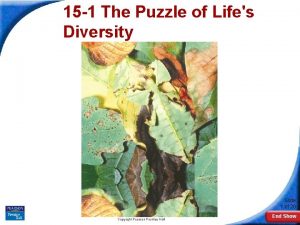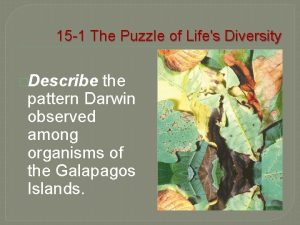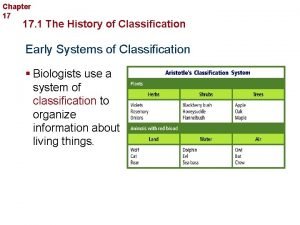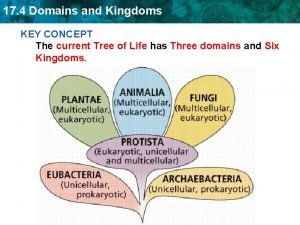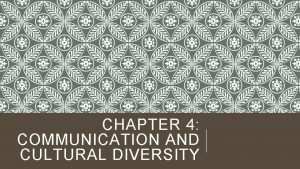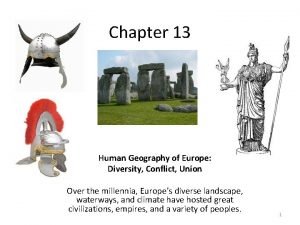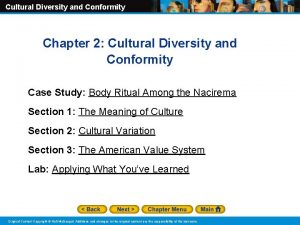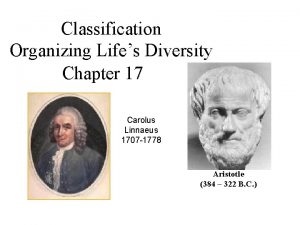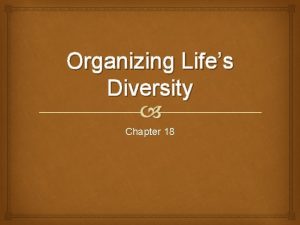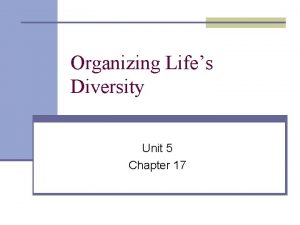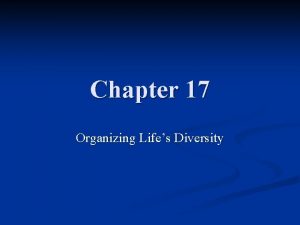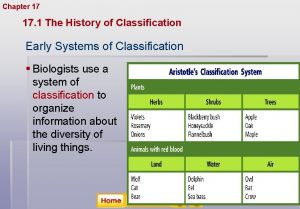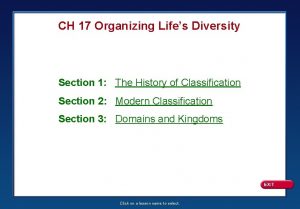Chapter 17 Organizing Lifes Diversity 17 3 Domains

































- Slides: 33

Chapter 17 Organizing Life’s Diversity 17. 3 Domains and Kingdoms Domain Bacteria § Eubacteria are prokaryotes whose cell walls contain peptidoglycan. § Eubacteria are a diverse group that can survive in many different environments. Classifying Using Biotechnology

Chapter 17 Organizing Life’s Diversity 17. 3 Domains and Kingdoms Domain Archaea § Archaea are thought to be more ancient than bacteria and yet more closely related to our eukaryote ancestors. § Archaea are diverse in shape and nutrition requirements. § They are called extremophiles because they can live in extreme environments.

Archaebacteria Types Methanogens sewage Thermoacidophiles Hot springs Great salt lakes Extreme Halophiles

Cyanobacteria “Blue-green algae” Only 200 species? In different conditions they grow differently Lots of colors Photosynthetic 7, 500 ? species

BASIC SHAPES OF EUBACTERIA ROD-SHAPED SPHERICAL SPIRILLA

Bad Bacteria!

Bacteria Caused Diseases • Bacteria can cause the following diseases: – – – Tuberculosis Pneumonia Strep throat Staph infections Scarlet fever Syphilis Gonorrhea Chlamydia Boils Tetanus Lyme disease Ear infections Many sexually transmitted diseases (STD’s) are caused by bacteria. • Gonorrhea • Syphilus • Chlamydia

salmonella Helibacter pilori E. coli anthrax

Botulism • One group of bacteria called clostridia, can form endospores. Clostridium botulinum, produces a toxin. If canned food is not properly sterilized these endospores can become active inside a can and the disease “botulism” can occur.

ANTIBIOTICS Antibiotics are drugs that combat bacteria by interfering with cellular functions Penicillin – interferes with cell wall production Tetracycline – interferes with protein production Sulfa drugs – produced in the laboratory Broad-spectrum antibiotics will affect a wide variety of organisms

Penicillin, an antibiotic, comes from molds of the genus Penicillium Notice the area of inhibition around the Penicillium.

Bacteria aren’t all Bad!

Root Nodules Atmospheric N 2 N “fixer” Plant roots 50% to 70% of the biological nitrogen fixation Nif. TAL: Nitrogen Fixation of Tropical Agricultural Legumes

Nitrogen Cycle

• Actinomycetes, produce antibiotics such as streptomycin and nocardicin.

Bacteria make Vitamin K

• Bacteria put the tang in yogurt and the sour in sourdough bread. • Saprobes help to break down dead organic matter. • Bacteria make up the base of the food web in many environments. Streptococcus thermophilus in yogurt

Sewage treatment

Oil Spills

Binary Fission • It involves the copying of the DNA and the splitting into two new cells.

Chapter 17 Organizing Life’s Diversity 17. 3 Domains and Kingdoms Viruses—An Exception § A virus is a nucleic acid surrounded by a protein coat. § Viruses do not possess cells, nor are they cells, and are not considered to be living. § Because they are nonliving, they usually are not placed in the biological classification system.

CHARACTERISTICS Non living structures Noncellular Contain a protein coat called the capsid Have a nucleic acid core containing DNA or RNA Capable of reproducing only when inside a HOST cell COPYRIGHT CMASSENGALE 22

CHARACTERISTICS Some viruses are enclosed in an protective DNA envelope Some viruses may have spikes to help attach to the host cell Most viruses infect only SPECIFIC host cells CAPSID ENVELOPE SPIKES COPYRIGHT CMASSENGALE 23

CHARACTERISTICS Some viruses cause disease Smallpox, measles, mononucleosis, influenza, colds, warts, AIDS, Ebola Some viruses may cause some cancers like leukemia Virus-free cells are rare MEASLES COPYRIGHT CMASSENGALE 24

VIRAL SHAPES Viruses come in a variety of shapes Some may be helical shape like the Ebola virus Some may be polyhedral shapes like the influenza virus Others have more complex shapes like bacteriophages COPYRIGHT CMASSENGALE 25

COMPLEX VIRUSES COPYRIGHT CMASSENGALE 26

BACTERIOPHAGES COPYRIGHT CMASSENGALE 27

ADENOVIRUS COMMON COLD COPYRIGHT CMASSENGALE 28

USED FOR VIRUS IDENTIFICATION RNA or DNA Virus Do or do NOT have an envelope Capsid shape HOST they infect COPYRIGHT CMASSENGALE 29

RETROVIRUSES The enzyme reverse transcriptase (or RTase), which causes synthesis of a complementary DNA molecule (c. DNA) using virus RNA as a template RTase COPYRIGHT CMASSENGALE 30

RETROVIRUSES HIV, the AIDS virus, is a retrovirus Feline Leukemia Virus is also a retrovirus COPYRIGHT CMASSENGALE 31

LYTIC AND LYSOGENIC CYCLES COPYRIGHT CMASSENGALE 32

PRION DISEASES Prions form insoluble deposits in the brain Causes neurons to rapidly degeneration. Mad cow disease (bovine spongiform encephalitis: BSE) is an example People in New Guinea used to suffer from kuru, which they got from eating the brains of their enemies COPYRIGHT CMASSENGALE 33
 Chapter 17 section 1 the history of classification
Chapter 17 section 1 the history of classification The puzzle of life's diversity
The puzzle of life's diversity Section 15-1 the puzzle of lifes diversity
Section 15-1 the puzzle of lifes diversity Chapter 17 organizing life's diversity
Chapter 17 organizing life's diversity Circle lifes
Circle lifes 4 lifes
4 lifes Count blessings song
Count blessings song Organizing life's diversity
Organizing life's diversity Why is genetic diversity important
Why is genetic diversity important Genetic diversity vs species diversity
Genetic diversity vs species diversity Chapter 2 worksheet organizing and administering
Chapter 2 worksheet organizing and administering Chapter 17 domains and kingdoms answer key
Chapter 17 domains and kingdoms answer key Concept mapping chapter 17 domains and kingdoms answer key
Concept mapping chapter 17 domains and kingdoms answer key Reproduction in bryophytes ppt
Reproduction in bryophytes ppt Chapter 30 section 2 diversity of mammals
Chapter 30 section 2 diversity of mammals Chapter 9 cultural diversity
Chapter 9 cultural diversity Chapter 8 study guide human resources culture and diversity
Chapter 8 study guide human resources culture and diversity Chapter 8 human resources culture and diversity
Chapter 8 human resources culture and diversity Diversity and human needs and development
Diversity and human needs and development Biological diversity and conservation chapter 5 answers
Biological diversity and conservation chapter 5 answers Chapter 4 communication and cultural diversity
Chapter 4 communication and cultural diversity Chapter 30 section 2 diversity of mammals
Chapter 30 section 2 diversity of mammals Chapter 26 section 3 insects and their relatives
Chapter 26 section 3 insects and their relatives Biology chapter 22 plant diversity answer key
Biology chapter 22 plant diversity answer key Chapter 18 the evolution of invertebrate diversity
Chapter 18 the evolution of invertebrate diversity Chapter 15 origins of biological diversity answers
Chapter 15 origins of biological diversity answers Diversity in the uk
Diversity in the uk Chapter 10 cultural diversity
Chapter 10 cultural diversity Cultural diversity and conformity section 3
Cultural diversity and conformity section 3 Cultural diversity and conformity chapter test form a
Cultural diversity and conformity chapter test form a Chapter 20 section 2 diversity of fungi
Chapter 20 section 2 diversity of fungi Animal diversity chapter
Animal diversity chapter Cultural diversity and conformity
Cultural diversity and conformity Chapter 4 growth diversity and conflict
Chapter 4 growth diversity and conflict

